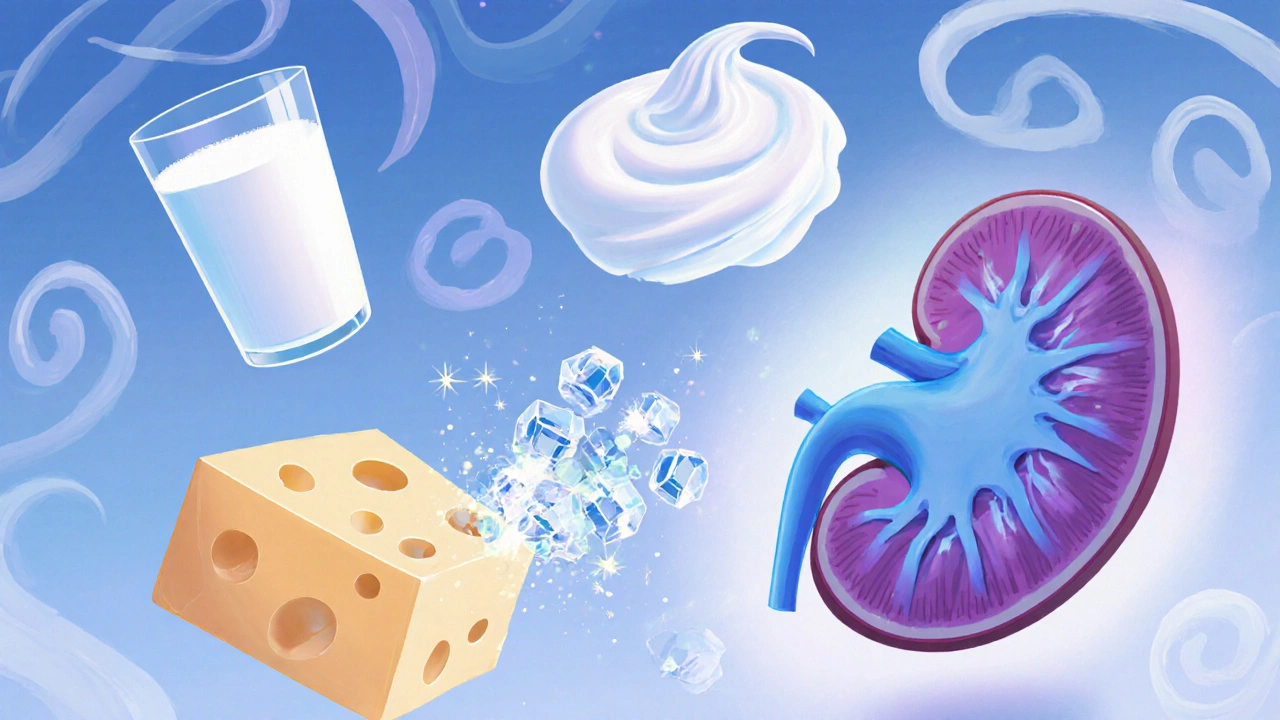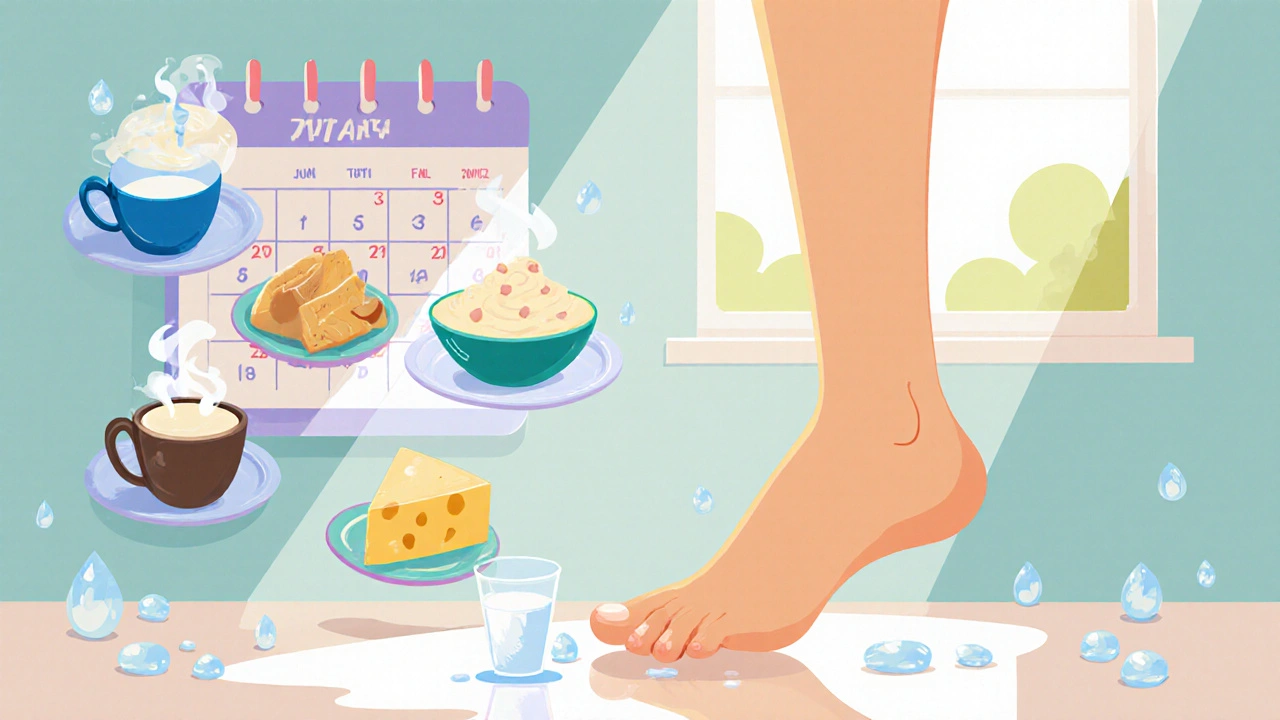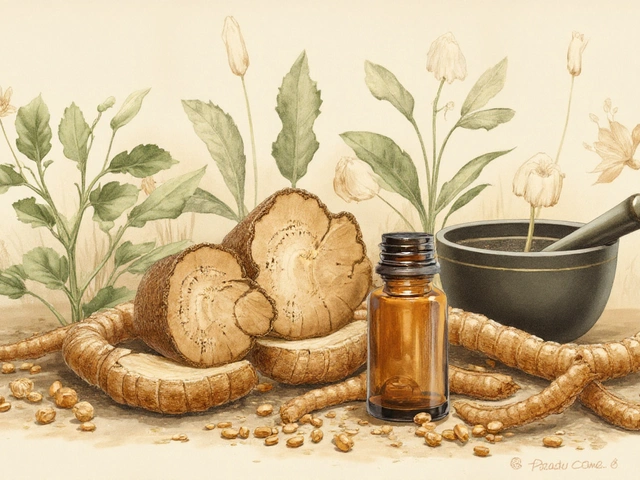Gout is a painful form of inflammatory arthritis caused by high levels of uric acid that crystallize in joints. When these crystals form, the classic sudden swelling and burning pain appear, most often in the big toe but also in knees, ankles, and elbows. While many people instantly think of red meat, seafood, and alcohol as gout triggers, dairy often flies under the radar. This article breaks down the science behind dairy and gout, shows which dairy choices are safe, and gives you a practical eating plan to keep flare‑ups at bay.
Why Uric Acid Matters
Uric acid is a waste product of purine metabolism. Purines are found in many foods, especially organ meats, anchovies, and certain legumes. Your liver converts purines into uric acid, which is then filtered by the kidneys and excreted in urine. When production outpaces excretion, serum uric acid rises, and crystals can form in cooler peripheral joints.
- Normal serum uric acid: 3.5-7.2 mg/dL for men, 2.6-6.0 mg/dL for women.
- Hyperuricemia (risk zone): >7 mg/dL for men, >6 mg/dL for women.
- Each 0.5 mg/dL increase roughly raises gout flare risk by 20 %.
Because kidneys play a starring role, anything that affects kidney function-dehydration, high‑protein loads, certain medications-will indirectly influence gout symptoms.
What Dairy Actually Contains
Dairy refers to milk and its derived products such as cheese, yogurt, butter, and cream. The key components that interact with uric acid are:
- Protein: Whey and casein are the main proteins. They contain very few purines compared with meat or legumes.
- Lactose: The natural sugar in milk. Unlike fructose, lactose has a minimal impact on uric acid production.
- Fat: Ranges from skim (0 % fat) to whole milk (≈3.5 % fat) and cream (≈30 % fat). Fat content can affect insulin sensitivity, which in turn influences kidney uric acid clearance.
- Calcium and Vitamin D: Both help maintain bone health and may modestly improve kidney filtration efficiency.
The low purine profile of dairy is why many clinical studies flag it as a protective food for gout sufferers.
Evidence from Clinical Studies
Several large‑scale cohort studies from the US, Europe, and Asia have compared gout incidence among dairy consumers versus non‑consumers.
- Health Professionals Follow‑up Study (2008): Men who drank ≥2 servings of low‑fat milk daily had a 25 % lower risk of developing gout over 12 years.
- European Prospective Investigation into Cancer and Nutrition (EPIC, 2015): High‑fat cheese showed no increase in gout risk, while low‑fat yogurt was linked to a 30 % risk reduction.
- Japanese Cohort (2019): Consumption of fermented dairy (yogurt, kefir) correlated with lower serum uric acid levels, likely due to probiotic effects on gut metabolism.
Across these studies, the common thread is that low‑fat dairy consistently lowers uric acid, whereas full‑fat dairy does not raise it and may be neutral.

Low‑Fat vs. Full‑Fat Dairy: What the Numbers Say
The table below summarizes how different dairy products affect serum uric acid based on peer‑reviewed data.
| Product | Typical Fat % | Average Change in Serum Uric Acid (mg/dL) | Key Study |
|---|---|---|---|
| Skim Milk (0 % fat) | 0 | -0.30 | HPFS 2008 |
| 2% Milk | 2 | -0.22 | HPFS 2008 |
| Whole Milk (3.5 % fat) | 3.5 | -0.05 (NS) | EPIC 2015 |
| Full‑Fat Yogurt | 4‑5 | -0.02 (NS) | Japanese Cohort 2019 |
| Low‑Fat Yogurt (≤2 % fat) | ≤2 | -0.28 | Japanese Cohort 2019 |
| Cheese (varies) | 20‑30 | ±0.00 | EPIC 2015 |
"NS" means not statistically significant. The take‑away? Choose low‑fat milk or yogurt for the strongest uric‑acid‑lowering effect; regular cheese is safe in moderation; whole milk offers little benefit but isn’t harmful either.
How to Build a Gout‑Friendly Dairy Routine
Below is a practical 7‑day plan that keeps dairy in the mix while staying under the typical uric‑acid‑raising threshold (≈300 mg of purines per day).
- Breakfast: 1 cup of skim milk + ½ cup of low‑fat Greek yogurt with fresh berries. The probiotics in yogurt improve gut health, which can further lower uric acid.
- Mid‑morning snack: A small slice of 30 %‑fat cheddar. Cheese adds calcium without adding purines.
- Lunch: Mixed salad with 2 oz of feta, olive oil dressing, and a side of quinoa. Feta is a low‑purine cheese; quinoa provides protein without excess purines.
- Afternoon snack: A glass of almond milk (if you like plant‑based alternatives) - note that almond milk contains virtually no purines and is low in calories.
- Dinner: Grilled chicken breast, steamed broccoli, and a baked potato topped with a spoonful of low‑fat cottage cheese.
- Evening: If you crave something sweet, enjoy a small bowl of low‑fat vanilla pudding made with skim milk.
Adjust portion sizes based on your total caloric needs, but keep the dairy servings at 2-3 cups per day to stay within the protective range seen in studies.

Common Pitfalls and How to Avoid Them
- Full‑fat ice cream: High in sugar and fat, which can impair kidney clearance of uric acid. Stick to frozen yogurt made with low‑fat milk.
- Processed cheese spreads: Often contain added sodium and preservatives that may increase blood pressure, a secondary gout risk factor.
- Excessive protein shakes: Whey protein itself is low‑purine, but many commercial shakes add fruit juices rich in fructose-a known uric‑acid booster.
- Skipping dairy altogether: Some gout patients eliminate dairy out of fear, but they miss out on calcium, vitamin D, and the modest uric‑acid‑lowering effect.
- Not staying hydrated: Even the best dairy choices won’t help if you’re dehydrated. Aim for at least 2‑2.5 L of water daily.
Frequently Asked Questions
Can full‑fat milk trigger gout attacks?
Full‑fat milk contains very few purines, so it doesn’t directly trigger gout. However, its higher calorie load can lead to weight gain, and excess weight is a risk factor for higher uric acid. If you’re watching calories, low‑fat milk is the safer bet.
Is cheese safe for someone with gout?
Yes. Most cheeses are low in purines. The key is portion control-about 30-40 g per serving-to keep sodium and saturated fat in check.
Do fermented dairy products like kefir help with gout?
Research from Japan suggests fermented dairy can modestly lower serum uric acid, likely because probiotics improve gut metabolism of purines and reduce systemic inflammation.
How much dairy is recommended per day for gout patients?
Around 2-3 servings daily (a serving = 1 cup milk or yogurt, 1‑2 oz cheese). This level matches the amounts linked to lower gout risk in major cohort studies.
Can plant‑based milks replace dairy for gout management?
Almond, soy, and oat milks contain virtually no purines and are low‑calorie, making them gout‑friendly. Just watch for added sugars, which can raise uric acid similarly to fructose.
Bottom Line: Dairy Can Be Your Ally
When you pick the right dairy-low‑fat milk, low‑fat yogurt, modest cheese portions-you’re essentially giving your body a low‑purine, calcium‑rich boost that helps kidneys flush out uric acid. Combine these choices with adequate hydration, limited alcohol, and a balanced overall diet, and you’ll see fewer painful gout flare‑ups.
Remember, every body reacts a little differently. Track your symptoms, note which dairy items keep you feeling steady, and adjust portions accordingly. With the right plan, dairy moves from a mystery factor to a useful tool in your gout‑management toolkit.





Sakib Shaikh
October 21, 2025 AT 14:33Listen up, folks – the science behind dairy and gout is crystal clear, even if your grandma’s kitchen myths aren’t. Skim milk isn’t just “low‑fat”, it’s practically a uric‑acid assassin, slashing levels by three‑tenths of a mg per dL. Yogurt, especially the fermented kind, packs probiotics that turn your gut into a detox factory – think of it as a tiny army marching against those nasty crystals. And don’t even get me started on cheese; a modest slice gives you calcium without any of the purine drama. So if you’re still thinkin dairy is the enemy, you’re seriously missin out.
Devendra Tripathi
October 21, 2025 AT 16:13Hold your horses – dumping all dairy just because “some study” says it helps is a reckless move, and the full‑fat stuff can add calories that pack on the pounds, which only makes gout worse. Stop glorifying skim milk like it’s a miracle cure.
Vivian Annastasia
October 21, 2025 AT 17:53Well, isn’t that just heart‑warming, another “miracle food” hype train. Of course, the article cherry‑picks low‑fat data while ignoring the fact that most people binge cheese and ice‑cream anyway, so the real‑world impact is negligible. It’s cute how they pretend dairy is a panacea, when the underlying metabolic pathways remain unchanged. If you’re looking for a quick fix, you’ll be disappointed.
John Price
October 21, 2025 AT 19:33Skip the sugar‑laden ice cream, stick with plain yogurt.
Nick M
October 21, 2025 AT 21:13The dairy lobby’s covert influence is well‑documented; selective reporting aligns perfectly with their profit motives, especially when proprietary data on full‑fat dairy’s impact on uric acid is conveniently omitted. Moreover, the jargon surrounding “purine‑free” is a smokescreen that masks the real metabolic load from saturated fats, which indirectly hampers renal clearance. In short, the narrative is engineered.
eric smith
October 21, 2025 AT 22:53Oh, please, you sound like you just read a conspiracy blog. The studies are peer‑reviewed, not some shady marketing brochure, and the data on low‑fat dairy is robust. Stop over‑dramatizing.
Erika Thonn
October 22, 2025 AT 00:33One might ponder the essence of nourishment and how dairy, as a symbol of pastoral tradition, intertwines with the human quest for balance. If we consider the body as a micro‑cosm, then each sip of milk becomes a philosophical dialogue between calcium and uric acid. Yet, a typo in our diet – a slip toward excess – can tip the scales. So, perhaps the true lesson lies not in numbers, but in mindful consumption.
Ericka Suarez
October 22, 2025 AT 02:13Enough of the flowery nonsense – this is about health, not poetry. Low‑fat dairy works, full‑fat doesn’t, and that’s the simple truth. Stop romanticizing cheese.
Esther Olabisi
October 22, 2025 AT 03:53Great summary! 👍 I’ve actually tried adding a cup of skim milk to my morning routine and felt less joint stiffness. Keep the tips coming, they’re super helpful! 😊
Ivan Laney
October 22, 2025 AT 05:33Let me set the record straight for anyone still lost in the fog of mixed messages. First, dairy is not a monolith; each product carries its own biochemical fingerprint that interacts differently with uric acid metabolism. Second, the so‑called “low‑fat advantage” is grounded in epidemiological data that consistently shows a 20‑30% reduction in gout incidence among regular skim‑milk drinkers. Third, the calcium and vitamin D synergy enhances renal filtration efficiency, a fact that is often downplayed by the mainstream media. Fourth, while full‑fat dairy does not raise uric acid significantly, it adds caloric density that can promote weight gain, a well‑known risk factor for gout. Fifth, the probiotic strains in fermented yogurts actively modulate gut flora, reducing systemic inflammation and, consequently, the likelihood of crystal formation. Sixth, moderate cheese consumption, kept within a 30‑gram serving, supplies essential nutrients without overloading purine pathways. Seventh, excessive protein shakes, especially those sweetened with fructose‑laden fruit juices, can negate the benefits of whey protein. Eighth, hydration remains the cornerstone; no amount of dairy can compensate for chronic dehydration. Ninth, individual variability means you should monitor serum uric acid after dietary changes to fine‑tune your regimen. Tenth, the evidence from the HPFS and EPIC cohorts is robust, with large sample sizes and long follow‑up periods that strengthen causal inference. Eleventh, the Japanese study adds a cultural perspective, highlighting the role of traditional fermented dairy in East Asian diets. Twelfth, as a nationalist, I take pride in promoting evidence‑based nutrition that benefits our population’s health. Thirteenth, misinformation spreads faster than real science on social platforms, so it is our duty to disseminate accurate data. Fourteenth, the bottom line: incorporate low‑fat milk and yogurt, keep cheese portions reasonable, stay hydrated, and watch your weight. Fifteenth, only then will you truly harness dairy as an ally in the battle against gout.
Kimberly Lloyd
October 22, 2025 AT 07:13Reading this makes me feel hopeful that small, consistent changes can lead to big relief. The idea of treating dairy as a tool rather than a villain aligns with many cultural practices that value balance. I plan to experiment with a daily cup of kefir and track my joint comfort. May this knowledge spread and help others find peace.
Jake Hayes
October 22, 2025 AT 08:53While enthusiasm is nice, the data clearly shows only low‑fat options help. Anything else is just filler.
parbat parbatzapada
October 22, 2025 AT 10:33Honestly, the whole dairy hype feels like another distraction from the real conspiracies – like how big pharma pushes meds while we chase milk to fix our joints. Even if you believe the studies, they’re funded by dairy giants, so why trust them? At the end of the day, it’s all about who profits, not our health. Yet, the occasional cup of yogurt does make me feel a bit less inflamed, so maybe there’s a grain of truth.
Casey Cloud
October 22, 2025 AT 12:13Here’s a practical tip try a smoothie with half a cup skim milk a handful of berries and a spoonful of low‑fat Greek yogurt it gives protein calcium and probiotics while keeping sugar low stay consistent and watch your uric acid levels
Brandy Eichberger
October 22, 2025 AT 13:53Thank you for the concise suggestion, it’s both elegant and effective. I’ll certainly incorporate that smoothie into my regimen.